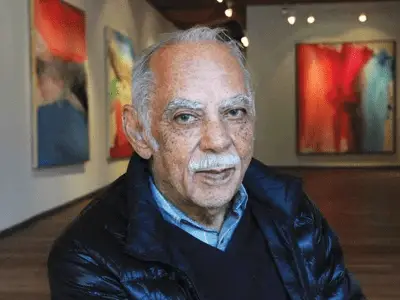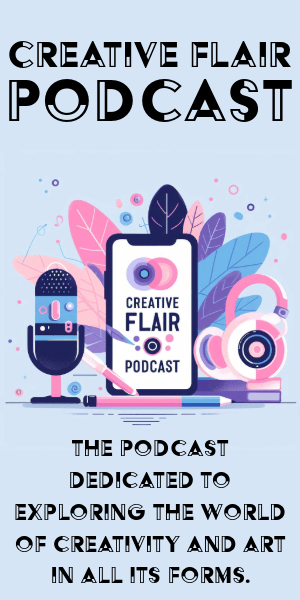(Skip to bullet points (best for students))

Born: 1926
Died: 2019
Summary of Edward Clark
Ed Clark was an American Colour Field painter who developed his style in the early 1950s during his time in Paris. He found Paris friendly and the environment encouraging as an African-American reared in the segregated South. During his time there, he developed a complex abstract style, which the Tachist painter Nicolas de Stael inspired greatly. His early work is known for his “push-broom technique,” approach, which promoted his complete physical participation in painting. He is also known for his colossal extent and the fact that he was one of the first artists to utilise curved canvases.
Biography of Edward Clark
Childhood
Edward Clark was born on 6 May 1926 in Storyville, New Orleans. When he was six he relocated his parents Merion and Edward Sr. to Baton Rouge where he and his dad’s great aunt resided in a shotgun home. Clark started primary school at this time, when he first was introduced to sketching. On one occasion, Clark and his classmates faced a challenge at his Catholic school: anybody who could make the finest sketch of the tree would earn a gold star. Clark took up the challenge and received recognition from his instructors for his creative skills and for the gold star, and this event increased Clark’s ambition to become an artist.
Two years later, the family of Clark moved to Chicago to the north. In 1943, at 17 years of age, he left school and joined the air force during World War II. He was stationed in the South Pacific for two years and came back to Chicago after he was released.
Early Life
With the help of the GI Bill, Clark enrolled with painter Louis Ritman at Chicago Art Institute in 1947. He left Chicago in 1952 and went to Paris. The African-American era was crucial to his growth overseas, since it provided chances and experiences for him during which segregation in the United States would not be accessible. Once in Paris, he attended and studied under Edouard Goerg and Ossip Zadkine at the renowned Académie de la Grande Chaumiere. Clark liked Chaumiere’s easygoing workshop atmosphere – in contrast to what he saw as the art institute Chicago’s rigid and sometimes oppressive approach. He also was exposed to a variety of artists and movements, including the CoBrA group (Copenhagen, Brussels, Amsterdam) and the gestural abstraction of Art Informel, besides his training at the Chaumiere. He was inspired mainly by the abstractions and heavily impasto lenses of the Russian-born artist Nicolas de Stael – notably his work, The Footballers. Clark has been applying vivid colours in tightly packaged block shapes from de Stael. The resultant pieces were distinguished by shapes which seem to resonate.
Mid Life
Clark’s financial assistance from the GI Bill expired in 1953 but, despite the probability of financial difficulties, chose not to return to the United States but to stay in Paris. Paris, according to Clark, was an unachievable place of social and creative freedom in the United States where racism abounded, black art, and artists were restricted mainly in libraries and community centres, which were less than the major art galleries. Clark said about this, “[Paris was]…the freest city and a genuine artist’s magnet. We encounter artists from various nations, regardless of class, ethnicity or political philosophy. We were artists, we were artists, nothing more.” During his visit to Paris, Clark shared his studio space with a number of other American painters, such as Herbert Gentry and Joan Mitchell.
While he would return to Paris several times during his life, Clark not only embraced the abstraction, but also started to paint on a colossal scale during this period. After struggling to locate paintbrushes that could suit his work, he developed the “push-broom technique,” in which a push-broom of a gardener was repeated like a paintbrush that enabled him to paint big areas effortlessly. Like Jackson Pollock, Clark would impulsively put his canvas on the floor and paint them. He next carried out what he called the “the big sweep,” in which he pushed the broom in an expedited way, creating bold, wide strands and giving a feeling of speed and dynamic movement to his gestures. These paintings are distinguished by vast areas dominated by many colours (typically three different colours) all over. As such, the paintings of Mark Rothko and Franz Kline are quite comparable. Clark earned great praise in France and was commended by a reviewer of Le Monde, Michel Concil-Lecoste. In 1953, Michel Tapie, the critic and curator, included the show of Clark’s American painters residing in France, making Clark the only African American to be present at the exhibition held at the Craven Gallery. He has also shown paintings in several prominent Paris galleries, including the Creuze Gallery, the Maeght Gallery and the Huit Gallery. And it was featured in the 1957 Dictionnaire de la Painture Abstraite book by Michel Seuphor.
In 1957, Clark moved to the U.S. to live in New York City, where he became a founding member of the Brata Gallery, an art cooperative on 10th Street. Several additional Abstract Expressionists of the second generation, including George Sugarmen, Al Held, Nicholas Krushenick, and Sal Romano, were also associated with the gallery. Clark started experimenting with “shaped” paintings around this period. This technique was imposed upon him at first because of financial difficulties; he started to paint paper to return to the canvas when he was financially safer. But when he returned to the canvas, he pasted paper to the surface so it extended over the edge of the canvas and limped. As a correction, Clark constructed an armature as a support beneath the paper. These “shapes” thus became both painting and collage and sculpture.
In 1966 Clark returned to Paris, where he stayed until 1969. In 1966, at Galerie Creuze, he had a one-man exhibition where art critic international R.C. Kenedy characterised his brushstrokes as forceful and violent. During this period, Clark started to produce oval paintings, which he viewed as a continuation of his form experiments. He attempted to integrate perception by imitating the eye shape by advancing towards a circular form. In the 1970s Clark developed this idea further with the development of elliptical sculptures.
Late Life
In the 1970s Clark started to travel frequently, visiting Greece, Nigeria, Mexico, Brazil and China, integrating colour and travel experience into his work.
Clark has also experimented with line and form in addition to changes in his colour pallet throughout his career. Many of his early pieces retained a strong horizontality, consistent with his broom’s thrust. But in the 1980s, he gave up his Color Fields three units for curved and multi-directional tubular shapes, a contrast with the static Color Fields of the 1950’s. In the 1990s and 2000s, he started using vertical strokes, coupled with floating masses of colour which crossed the plane of the image and resulted in gigantic abstract compositions, which represent his whole career in experiments with colour, shape and line.
Ed Clark passed away in 2019 and worked in New York City and frequently went back to Paris. He appeared in the film Story of a Three Day Pass (1967) by Melvin van Peebles. He also painted a mural inside the aircraft of the late Reginald Lewis, a multimillionaire who owns a snack food and a grocery store empire Beatrice Foods. During his career, Clark has struggled to stay current, and his style is always changing.
Famous Art by Edward Clark
The City
1952

The City is one of Clark’s first big abstraction attempts. The painting developed as he worked on a realistic depiction of the city; not content with its results, he “destroy” the picture with his brush, but discovered that his devastation had pleased him. When all over executed, the colours seem almost to converse with one other.
Untitled: Paris Series 1988
1988

This piece shows Clark’s shift from the 1950s Color Fields towards more dynamic shapes of the tubes. Clark, unlike the more discreet Color Fields with a limited intermingling of colours and forms, juxtaposed its forms and blended its colours to imply a conversation with one another.
Pink Wave
2006

In a more recent piece, Clark’s continuing interest in the meaning of action and action and the presence of the artist’s hand is shown.
BULLET POINTED (SUMMARISED)
Best for Students and a Huge Time Saver
- Ed Clark is an American Colour Field painter who developed his style in the early 1950s during his time in Paris.
- He found Paris friendly and the environment encouraging as an African-American reared in the segregated South.
- During his time there, he developed a complex abstract style, which the Tachist painter Nicolas de Stael inspired greatly.
- With the help of the GI Bill, Clark enrolled with painter Louis Ritman at Chicago Art Institute in 1947.
- He left Chicago in 1952 and went to Paris.
- The African-American era was crucial to his growth overseas, since it provided chances and experiences for him during which segregation in the United States would not be accessible.
- He was inspired mainly by the abstractions and heavily impasto lenses of the Russian-born artist Nicolas de Stael – notably his work, The Footballers.
- While he would return to Paris several times during his life, Clark not only embraced the abstraction, but also started to paint on a colossal scale during this period.
- After struggling to locate paintbrushes that could suit his work, he developed the “push-broom technique,” in which a push-broom of a gardener was repeated like a paintbrush that enabled him to paint big areas effortlessly.
- Clark earned great praise in France and was commended by a reviewer of Le Monde, Michel Concil-Lecoste.
- In 1966 Clark returned to Paris, where he stayed until 1969.
- In 1966, at Galerie Creuze, he had a one-man exhibition where art critic international R.C. Kenedy characterised his brushstrokes as forceful and violent.
- During this period, Clark started to produce oval paintings, which he viewed as a continuation of his form experiments.
- He attempted to integrate perception by imitating the eye shape by advancing towards a circular form.
- In the 1970s Clark started to travel frequently, visiting Greece, Nigeria, Mexico, Brazil and China, integrating colour and travel experience into his work.Clark has also experimented with line and form in addition to changes in his colour pallet throughout his career.
- He appeared in the film Story of a Three Day Pass (1967) by Melvin van Peebles.
Information Citations
En.wikipedia.org, https://en.wikipedia.org/.


























